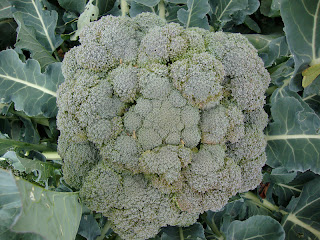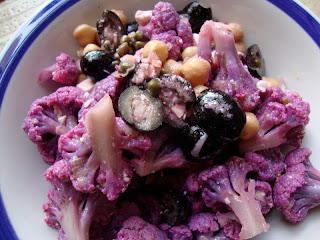10. The third broccoli plant of the season to reach harvest size was the Premium Crop. The Premium Crop produced a medium-sized head that I harvested on December 13, which was 63 days after transplanting. The Premium Crop, like the two earlier broccoli plants before it, had the good fortune of producing its broccoli head in what turned out to be (at least so far, knock on wood) the coolest part of this mild winter. Because of which, the Premium Crop reached harvest size slowly, and I managed to harvest it before it showed any signs of being past its prime. I cooked the Premium Crop into a broccoli-cheddar soup.
 |
| Premium Crop Broccoli |
9. By the time the fourth broccoli plant of the season, the Marathon Broccoli, was ready to harvest, we were enjoying an unseasonably (even for Austin) warm January, which meant that I found myself in a sudden state of broccoli abundance, with main heads of the later plants and side heads of the earlier plants all reaching harvest size at once. I harvested the Marathon Broccoli on January 6, 87 days after transplanting. I made the Marathon Broccoli into a salad that wasn't very successful because I blanched the broccoli to make the salad, and it just didn't hold up to even a couple of minutes of cooking the way that cauliflower does. The salad tasted good but the texture was not great, so I'll be sticking to cauliflower salads for the time being.
 |
| Marathon Broccoli |
8. This was the first year that I was able to grow broccoli and cauliflower in a full-sun location. Last year I grew them in the shady backyard and, years before that, my community garden plot was partially shaded. As a result of the sunny location, almost all of the main broccoli heads were larger than any I had grown before. But it was the broccoli side shoot production that really amazed me this year, turning what I thought was a single-harvest event into a two-month-long broccoli season. The Packman Broccoli started the broccoli season with the first main head on November 28, then followed with several ready-to-harvest side shoots by the first week in January. The combined size of the "side" shoots far exceeded the size of the original main head, explaining why some gardeners advise harvesting the central stalk early to encourage side shoot growth. Given the lack of side shoots in my broccoli-grown-in-the-shade history, I thought those people were crazy, but the Packman showed me how huge a second harvest can be. Side shoot harvest continued until January 26, when I harvested the side shoots of the Premium Crop and Marathon broccoli plants, officially closing out the broccoli season.
 |
| Packman Broccoli Side Shoots |
 |
| Premium Crop and Marathon Side Shoots |
7. The last broccoli plant to produce its central head was the Arcadia Broccoli, which I harvested on January 13, a full 94 days after transplanting. It was a large, dense broccoli head but I'm not sure about its flavor because I gave it to some friends. The exceptional quality of the Arcadia Broccoli was its long time to harvest, given that so many times I pick out variety of broccoli transplants, only to have them all reach harvest size in the same week. So, in the land of warm winters and fast broccoli growth, it is nice to know of Arcadia and its slower-growing ways.
 |
| Arcadia Broccoli |
6. The first cauliflower of the season to emerge from within its leaves and, once visible, quickly grow to harvest size, was the white Snow Crown cauliflower. I cooked the white cauliflower into a cauliflower curry.
5. I planted three heads of cabbage this year but lost one to an omnivorous neighborhood mammal on a health kick. I harvested the Fast Vantage Cabbage on January 20, or 97 days after transplanting into the front yard garden. Sliced and cooked into a stir fry with tempeh and black bean sauce, the Fast Vantage was sweet and tender, making me wonder why cabbage has such a bland reputation. Fresh cabbage is wonderful and takes a long, cool season to grow, making it something of a delicacy here in Texas where the hot season is reliably long and the cool season is anything but reliable. And, as any gardener knows, the omnivorous neighborhood mammals only eat the best, and the rarest, that a garden has to offer.
 |
| Fast Vantage Cabbage |
4. The biggest broccoli head of the season was produced by the Blue Wind Broccoli, which I harvested on December 6 and baked into a Broccoli Cheese Pie. The Blue Wind Broccoli also went on to grow large side shoots that made their way into another large batch of broccoli cheddar soup on January 11, making the Blue Wind the most productive of the broccoli plants this season.
 |
| Blue Wind Broccoli Side Shoots |
3. The purple Graffiti Cauliflower reached harvest size at the same time as the yellow cauliflower, in the middle week of January, which, for this season, was the absolute peak of cruciferous abundance. Between January 11 and 20, I harvested the several broccoli side shoots (filling the bowl in the photo above), the Arcadia broccoli, two cauliflower, and a cabbage. And that's not counting all the cruciferous greens, like mustard and kale and Asian greens, reaching maturity in the front yard garden at the same time. Needless to say, if there were an LD50 for cruciferous vegetables, I would now be able to report on it. Between the yellow and the purple cauliflower, I thought that the yellow one was going to reach its harvest day a bit sooner, but one day I walked around the house to find that the entire purple cauliflower plant had wilted. So I harvested the Graffiti Cauliflower on January 15, which was 96 days after transplanting, and revived it by placing its stem into water.
 |
| Graffiti Cauliflower |
I used the purple cauliflower to make a magenta-colored cauliflower salad. I know, cauliflower salad sounds about as appetizing as dormitory food. But last winter I discovered a recipe for Italian-Style Cauliflower Salad in the The Victory Garden Cookbook, an old-school gardener's guide to what to do with all of those vegetables, and since then cauliflower salad has been one of my take-to-work-for-lunch staples. The salad combines cauliflower, blanched for three minutes to mellow the raw cauliflower edge, with olives, capers, and a lemon-garlic-olive oil dressing. I usually add a can of garbanzo beans and a chopped hunk of feta cheese to make the salad more substantial. Before cooking the purple cauliflower, I read that adding vinegar to the water helps the cauliflower to retain its color (and the anthocyanin nutrition associated with it) during cooking. Given that Austin water is fairly basic, I added a generous half cup of vinegar to the boiling water that I used to blanch the cauliflower, which remained purple but took on a bit more of a pink-purple, or magenta, shade in the water.
2. The Cheddar Cauliflower was ready to harvest on January 17, or 98 days after transplanting, but I didn't harvest it until January 20, and it used those few extra sunny days on the plant to grow into the Ten Pound Cauliflower. Now, to be honest, we don't have a scale, so I don't know for sure what the Cheddar Cauliflower weighed at harvest time. I just know that it was ginormous and far heavier than our eight-pound cat. Seriously. I decided to bake it, in the style of macaroni-and-cheese, simply substituting the cauliflower for pasta. But all that cauliflower didn't fit in the three-quart baking dish, so that day I also had an improvised cauliflower-mayo-and-whatever's-in-the-fridge salad for lunch, before the baked cauliflower for dinner. Like I said, it was a week of cruciferous abundance. About that baked cauliflower... it tasted awfully good but that much cauliflower, even though I blanched it before baking, released a whole lot of water during cooking, so the dish didn't look appetizing, more like a not-yet-pureed soup than a baked dish. I'll have to work on that.
 |
| Cheddar Cauliflower |
 |
| At harvest time, with kitty and cabbage for scale |
1. The Veronica Romanesco Cauliflower, being both the last of the cauliflowers to reach harvest size – on January 29, a full 110 days after transplanting – and the coolest-looking vegetable that I have ever grown, inspired this whole list. It was the Romanesco that put the whole season into a line, leading from the earliest broccoli, to all those unexpected broccoli side shoots, to the cauliflowers in bright colors, and finally to the apex of the season, the bright yellow-green Romanesco cauliflower with its whorled florets. The Romanesco was so crazy, built looking that I didn't want to cut it into pieces because it felt too much like I was ruining mother nature's personal art project. But as Lee said, You might as well cut it up now that you've cut it off the plant. So I carefully disassembled the Romanesco cauliflower, leaving as many florets as I could intact and marveling over how each floret really was a miniature version of the whole head. In fact, considered individually, each floret looked like a miniature, yet to-scale, version of a magical mountain where gnomes, the type that might nurse a wandering Snow White back to health, might live. And, in case of doubts, I was quite sober as I was thinking all of this, drinking my morning chai as I made the final Italian-Style Cauliflower Salad of the season, this time adding pasta and Parmesan cheese (instead of garbanzo beans and feta) to create a couple of satisfying meals. With the crunch of cauliflower, a taste in between broccoli and cauliflower, and its fractal good looks, Romanesco cauliflower is now on my list of favorite vegetables.
 |
| Veronica Romanesco Cauliflower |
Italian-Style Cauliflower Salad
Adapted from The Victory Garden Cookbook
1 large head of cauliflower
1 cup pimento-stuffed green olives, sliced (or black olives)
2 tablespoons capers
1 (15 ounce) can of garbanzo beans, drained and rinsed
4 ounces feta cheese, crumbled
1 or 2 cloves garlic, crushed
2 tablespoons lemon juice
1/2 cup extra virgin olive oil
1 teaspoon sea salt
freshly ground black pepper
[OR, instead of the garbanzo beans and feta cheese, substitute:
1/2 pound pasta, cooked according to package, rinsed, and cooled
1 cup grated Parmesan cheese]
Disassemble the cauliflower and chop into bite-size pieces. Soak the cauliflower pieces in water to remove dirt or bugs, then rinse. Blanch the cauliflower pieces in boiling, salted water for three minutes, then remove immediately, drain, and shock in ice water to cool. Drain the cauliflower pieces.
In a large bowl, combine the olives, capers, garbanzo beans and feta cheese (or pasta and Parmesan cheese), and cauliflower pieces. In a small bowl, whisk together the garlic, lemon juice, olive oil, sea salt, and pepper. Pour the dressing over the cauliflower mixture and stir well to combine. Refrigerate and serve cold or room temperature.


No comments:
Post a Comment